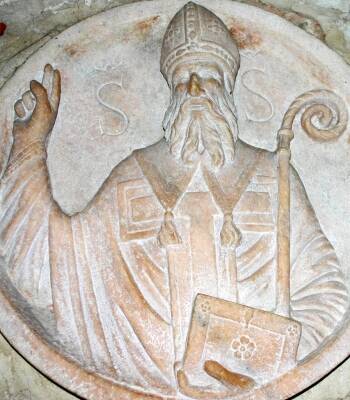MILAN—Holy Week begins and ends with joy—from the faith shared and celebrate at the Traditio Symboli on Palm Sunday eve and the triumph of Jesus entering Jerusalem to the celebration of the triumph of life at Easter. Late in the week come betrayal and judgement, outrageous pain and cruel death. Early in the week, though, are quiet days of getting ready, asking questions, considering possibilities. We need this quiet time.
Milan is full of churches. Most of them can provide quiet space for our prayer and reflection, and a number preserve relics of our shared Christian past. They may make demands on our ability to reach beyond the surface and to fill in a fuller picture from hints and outlines. But they reward our time, our restful gaze, our openness to discovery.
One such rich place is the church of San Simpliciano, which has been providing a support for faith since the late 300s. This is one of four basilicas built by the towering figure of St. Ambrose, bishop of Milan from 374 to 397. The church in Milan had seen a lot of persecution before Constantine's Edict of Milan legalized Christianity. The church then began to prosper. Ambrose built his basilicas near the city gates leading in four directions, and they took on the names of groups of saints, the martyrs, the apostles, the virgins and the prophets. After his death in 397, Ambrose was buried in the Basilica of the Martyrs, which took on his name. Saint Simplicianus was the second successor as bishop after Ambrose; the Basilica of the Virgins was renamed for him, and here he lies buried.
Another great name enters Milan's rich story in 384, that of the man who became St. Augustine. In 384 he was not yet a saint. But he was a man who was searching, probing and asking questions, testing the spirits that drove him. First he found Ambrose, who "welcomed me as a father would and like a good bishop approved of my journeying," according to his Confessions. Still, he was not ready to accept the Christian faith and way of life. But Ambrose could not be the spiritual director he needed.
Augustine had gotten through his doctrinal doubts, and he "liked the Way, which was our Savior, though the tight and narrow parts of that way" annoyed him. So God put it in his mind to go to Simplicianus, "whom I considered to be your good servant, and your grace shone in him. I heard that since his youth he lived most devoted to you." Now he had grown old, and to Augustine he seemed to have become a great expert in studying God's ways. "And so he was! So I wanted to share with him my inner turmoil so he might teach me how best I, as I was, could walk in your ways."
That is quite an endorsement! From one saint-to-be about a wise and holy mentor, guide, companion on the road. One intently searching, the other guiding that search. We all need help from time as we make our authentic way. Maybe it can sound trite, an easy image, our life as a journey or pilgrimage, our walking the camino to a holy goal. But it speaks a deep truth.
Holy Week begins with a triumphant walk as Jesus makes his way to Jerusalem. It includes his walking from the upper room to Gethsemane and later his prisoner walk to the lockup and Pilate and Herod. It concludes with his painful way of the cross, where his mother and Simon and Veronica and the women of Jerusalem try to ease his way. In the church of San Simpliciano the figure of an angel introduces the way of the cross by pointing and indicating words from Isaiah, "This is the way. Walk on it!"
Augustine goes on to tell a story of Simplicianus in Rome. There was a famous orator, Victorinus; everybody knew him. He indicated to Simplicianus that he was a Christian. "But I don't see you in church," Simplicianus replied. And Victorinus came back, "Do walls make a Christian?" It's hard to fight some logic. But Simplicianus was successful with Victorinus, who did in fact become a baptized Christian.
I sat by Simplicianus's grave, where his jeweled corpse rests visible under the main altar. I read again Augustine's fine words about him and thought of spiritual guides and the need we all have for each other. We need companions to walk the way with us, and we need to be there for our sisters and brothers. We are in this together, and we walk our pilgrim path in fine company, fine, faithful company indeed.








